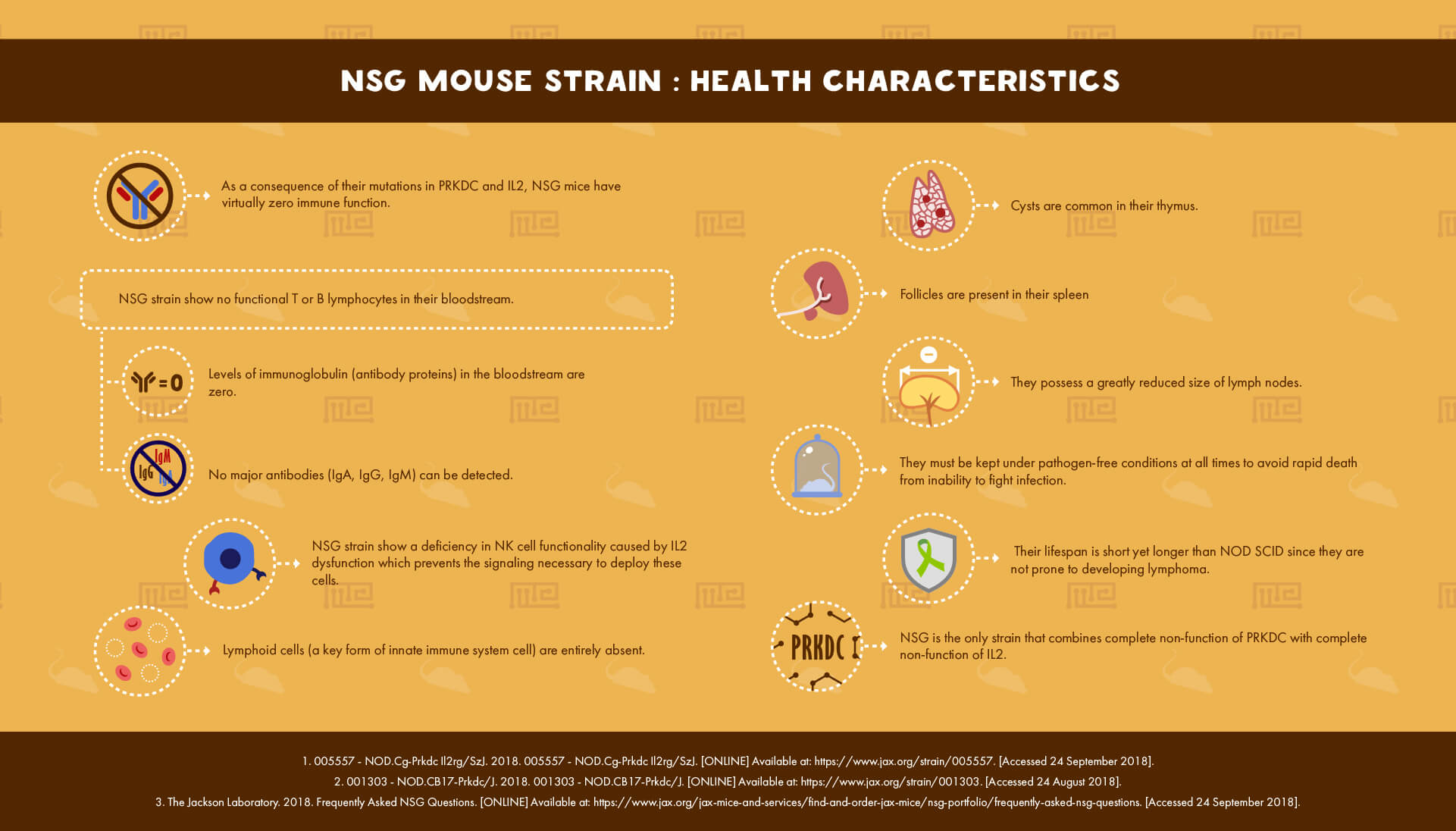History
NSG mice were developed from the NOD SCID strain, which in turn was derived from a stock of BALB/c mice which spontaneously acquired a mutation in the protein kinase PRKDC, conferring severe combined immunodeficiency (SCID).[1][3]
To create a strain with even more extreme immune dysfunction, a stock of the NOD SCID strain were crossbred with a B6 strain that carried an X-linked mutation in the cytokine interleukin 2. After several generations, this breeding produced NSG, which is now housed at the Jackson Laboratory.[1][4]
Behavioral Characteristics & Handling
The Jackson Laboratory claims that NSG mice do not display any “gross behavioral abnormalities” and that they breed well in an enclosure that is sufficiently clean.[4]
One paper shows that NSG mice, unlike the C57BL/6J strain, do not exhibit pathological behavioral changes following repeated mild closed head injuries. Injured NSG mice showed normal behavior in the elevated plus maze, forced swim test, Morris water maze, rotarod, and novel object recognition tests. The researchers attribute this to an absence of neuroinflammation after injury in this strain.[5]
No specific information on the ease of handling of this strain could be found, other than the need to ensure sterility at all times to avoid infecting the mice. Gloves and masks must be worn at all times when handling this strain. If possible, avoid using your hands and instead move the mice with forceps.[4]
Health Characteristics
As a consequence of their mutations in PRKDC and IL2, NSG mice have virtually zero immune function. PRKDC is required to mend double-strand breaks in DNA and for producing antigen-specific receptors on lymphocytes. IL2 regulates immune cell differentiation.[1]
As with NOD SCID mice, individuals of the NSG strain show no functional T or B lymphocytes in their bloodstream. Levels of immunoglobulin (antibody proteins) in the bloodstream are also zero, with none of the major antibodies (IgA, IgG, IgM) being detectable.[1][3]
In contrast to NOD SCID which has no adaptive immune function but normal natural killer (NK) cells,[3] NSG is also deficient in NK cell functionality. IL2 dysfunction prevents the signaling necessary to deploy these cells. Moreover, lymphoid cells (another key form of innate immune system cell) are entirely absent. Further abnormalities in the lymphatic system of these mice include cysts being commonly found in the thymus, follicles present in the spleen, and a greatly reduced size of the lymph nodes overall.[1][4]
As with NOD SCID, they must be kept under pathogen-free conditions at all times to avoid rapid death from inability to fight infection. Even under such conditions, they have a short lifespan, although they live longer than NOD SCID since they are not prone to developing lymphoma.[4]
NSG should not be confused with other strains that have a mere deficiency in IL2. NSG is the only strain that combines complete non-function of PRKDC with complete non-function of IL2.[4]
Major Experimental Uses
The complete absence of immune function in NSG mice makes them perfect for use in xenografting experiments, as they will not reject grafted tissue from any source. They find a key application in cancer research through human lung tumor grafting, as well as in pancreatic islet grafting for type 1 diabetes treatment.[1][4]
Naturally, this strain can also be applied to the study of immune deficiency disorders such as SCID or AIDS in humans, as well as inflammatory and autoimmune disorders. As a model for the most severe kinds of immune deficiency, they are superior to NOD SCID.[4]
Further uses for NSG mice are found in toxicological and virological research.[1]
References
- 005557 – NOD.Cg-Prkdc Il2rg/SzJ. 2018. 005557 – NOD.Cg-Prkdc Il2rg/SzJ. [ONLINE] Available at: https://www.jax.org/strain/005557. [Accessed 24 September 2018].
- Common Mouse Research Models. [ONLINE]. Available at: https://web.archive.org/web/20150724114553/https://www.research.uky.edu/dlar/documents/CommonMouseResearchModels.pdf [Accessed 20 July 2018]
- 001303 – NOD.CB17-Prkdc/J. 2018. 001303 – NOD.CB17-Prkdc/J. [ONLINE] Available at: https://www.jax.org/strain/001303. [Accessed 24 August 2018].
- The Jackson Laboratory. 2018. Frequently Asked NSG Questions. [ONLINE] Available at: https://www.jax.org/jax-mice-and-services/find-and-order-jax-mice/nsg-portfolio/frequently-asked-nsg-questions. [Accessed 24 September 2018].
- Gold, E. M., Vasilevko, V., Hasselmann, J., Tiefenthaler, C., Hoa, D., Ranawaka, K., … Cummings, B. J. 2018. Repeated Mild Closed Head Injuries Induce Long-Term White Matter Pathology and Neuronal Loss That Are Correlated With Behavioral Deficits. ASN NEURO, 10.


